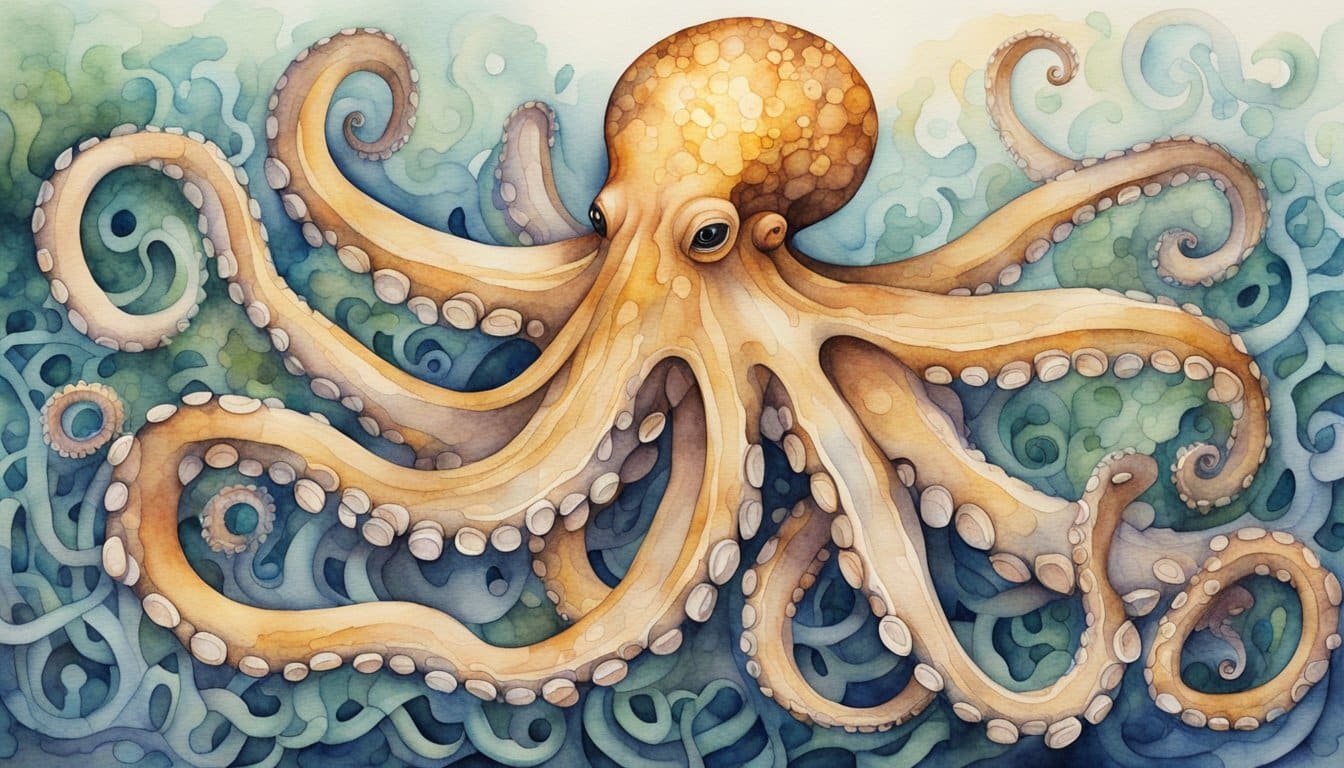Understanding the Octopus Brain
The octopus brain is an extraordinary organ, distinct in structure and function from the brains of other invertebrates, showcasing a surprising level of intelligence and complex behavior.
Anatomy and Structure
The central brain of octopuses encircles their esophagus, which is an unusual architecture among mollusks. This arrangement consists of several lobes, including the prominent optic lobe which processes visual information, and the vertical lobe, crucial for learning and memory. Each octopus possesses a total of nine brains – a central brain and a smaller brain in each of its eight arms that controls movement.
Central Brain and Intelligence
Octopuses exhibit remarkable intelligence that stands out among invertebrates. Their central brain plays a significant role in decision-making and problem-solving skills. Studies on octopuses have demonstrated abilities such as navigating mazes and solving puzzles, which implies a high level of cognitive processing akin to that of vertebrates.
Neurobiology and Neuron Function
An octopus’s neurons, or nerve cells, are distributed throughout its body, particularly in the central brain and the optic and vertical lobes. The nervous system of an octopus is more complex than most other invertebrates and even some vertebrates, which is partly why these cephalopods display such sophisticated behavior. The neuron function in octopuses reveals a great deal about their sensory perception and their capacity for learning and memory.
Behavior and Cognition

Octopuses have captivated researchers with their remarkable behavior and cognitive abilities. They demonstrate a varied range of fascinating behaviors indicating a sophisticated brain capable of complex functions.
Learning and Memory
The octopus brain supports a remarkable capacity for learning and memory. Experiments have shown that octopuses can navigate mazes and solve problems, which suggests not only short-term memory but also long-term memories. For example, in an experiment on learning, octopuses recalled how to open a container to retrieve food inside even after a short period of training.
Tool Use and Problem Solving
Octopuses exhibit intelligent tool use and problem-solving skills. They are known to gather coconut shells and use them to construct shelters, an advanced behavior observed in only a few non-human species. These behaviors are indicative of a complex nervous system and high cognitive capacity, as detailed in research on cephalopod brain and learning.
Observational Learning and Mimicry
Observational learning and mimicry are key aspects of cephalopod intelligence. Octopuses can learn new behaviors by watching others, which is a sign of complex cognitive functioning. Such capacity for learning extends to their camouflage skills, enabling them to blend into environments—a behavior that is not just instinctual but also learned and improved through observation. Further reading on this facet of octopus intelligence can be found in studies about the octopus with two brains.
Evolution and Genetic Research

The octopus’s brain is a marvel of the animal kingdom, reflecting a unique path in evolution, with researchers unraveling the complex dance of genes and adaptations that set these creatures apart.
Genome and Genetic Insights
The genetic blueprint of the octopus reveals a staggering array of genetic novelties. A study of the California two-spot octopus showed no signs of whole-genome duplications, a contrast to vertebrate evolution, yet it displayed an impressive expansion of gene families. For instance, the protocadherin genes known for mediating neural development are found in abundance in the octopus genome, hinting at their potential role in brain complexity.
Evolutionary Development
The octopus brain developed through a series of unique adaptations, suggesting an independent evolutionary trajectory. Unlike their distant cuttlefish and squid relatives, octopuses boast large lobes and advanced nervous systems that oversee intricate behaviors. This sophistication may arise from the evolutionary inventions, including gene editing abilities and neural rejuvenation, seen in species like Octopus vulgaris, providing a clue to their impressive cognitive capabilities.
Comparison with Vertebrates
While belonging to invertebrates, octopuses show some remarkable parallel evolution with vertebrates concerning their nervous systems. The detailed structural and functional properties of the octopus brain resonate with vertebrate brains, although they emerged from distinctly different evolutionary paths. From complex behaviors to brain-body coordination, octopuses and vertebrates might be distant cousins in the grand family tree of life, having developed similar solutions to nature’s multifaceted problems through convergent evolution.
Interaction with the Environment

Octopuses are brainy invertebrates with a knack for blending into their surroundings and interacting cleverly with their marine world. Their sophisticated nervous systems and remarkable arms allow for a complex and nuanced engagement with various environmental challenges.
Arm Control and Coordination
Each of the octopus’s eight arms operates with a mind-boggling degree of autonomy. Thanks to a bundle of nerve fibers that run down each limb, an octopus can let its arms act independently, allowing it to explore, manipulate objects, and move with agility. The central brain provides high-level commands but doesn’t micromanage, granting each arm the freedom to execute complex tasks like hunting or creating makeshift dens.
Sensory Input and Response
An octopus’s arm is not just for movement; it’s studded with sensors that can detect changes in the environment, from the texture of a rock to the chemistry of the water. This constant flow of sensory input to the visual system and brain informs the creature’s behavior, refining its camouflaging skills or cueing a swift retreat to its safe haven, commonly an aquarium or natural hideout. By processing visual information from its eyes, an octopus assesses its environment, coordinating its color and texture with the surroundings for near-perfect camouflage.
Adaptation to Habitats
From the shallow pools of coastal areas to the shadowy depths of the open ocean, octopuses have evolved to master their diverse habitats. Each species exhibits specific adaptations that enable it to thrive. For instance, adjustments in limb length or suction-cup sensitivity allow these mollusks to interact effectively with their environment, whether they’re skillfully catching prey or retreating into narrow dens to evade predators. Octopuses’ unique ability to adapt is evident in their varied hunting techniques, which reflect the rich dynamism of their ecological niches.
Technological Advances in Octopus Study

Recent years have witnessed remarkable advancements in the technology used to study the octopus, allowing researchers to explore the depths of cephalopod neurobiology like never before.
Brain Activity Monitoring
Neuroscientists are now equipped with sophisticated recording equipment like EEG and data loggers to track brain activity in octopuses. These devices capture the oscillations of neural networks, painting a clearer picture of how octopus brains function during various tasks. Studies on octopus brains highlight how this technology is crucial in unraveling the unique aspects of cephalopod intelligence.
Behavioral Experiments
With the aid of lab equipment from simple mazes to complex virtual reality systems, researchers are designing behavioral experiments to test the cognitive abilities of octopuses. The way octopuses interact with these environments is recorded using high-resolution cameras and data loggers, providing a panorama of their problem-solving prowess. Insights from these experiments help interpret how neural structures translate into behaviors, shedding light on the links between the physical brain and cognitive function.
Genomic Sequencing Techniques
Illuminating the genetic blueprint of the octopus, genomic sequencing techniques have leapt forward. Scientists can now sequence entire genomes with greater speed and lower costs, thanks to next-generation sequencing technology. This data provides a monumental leap in understanding the molecular underpinnings of octopus brain development and plasticity. Researchers examining the octopus brain atlas are starting to unravel the genetic components that make these creatures so unique in the animal kingdom.

